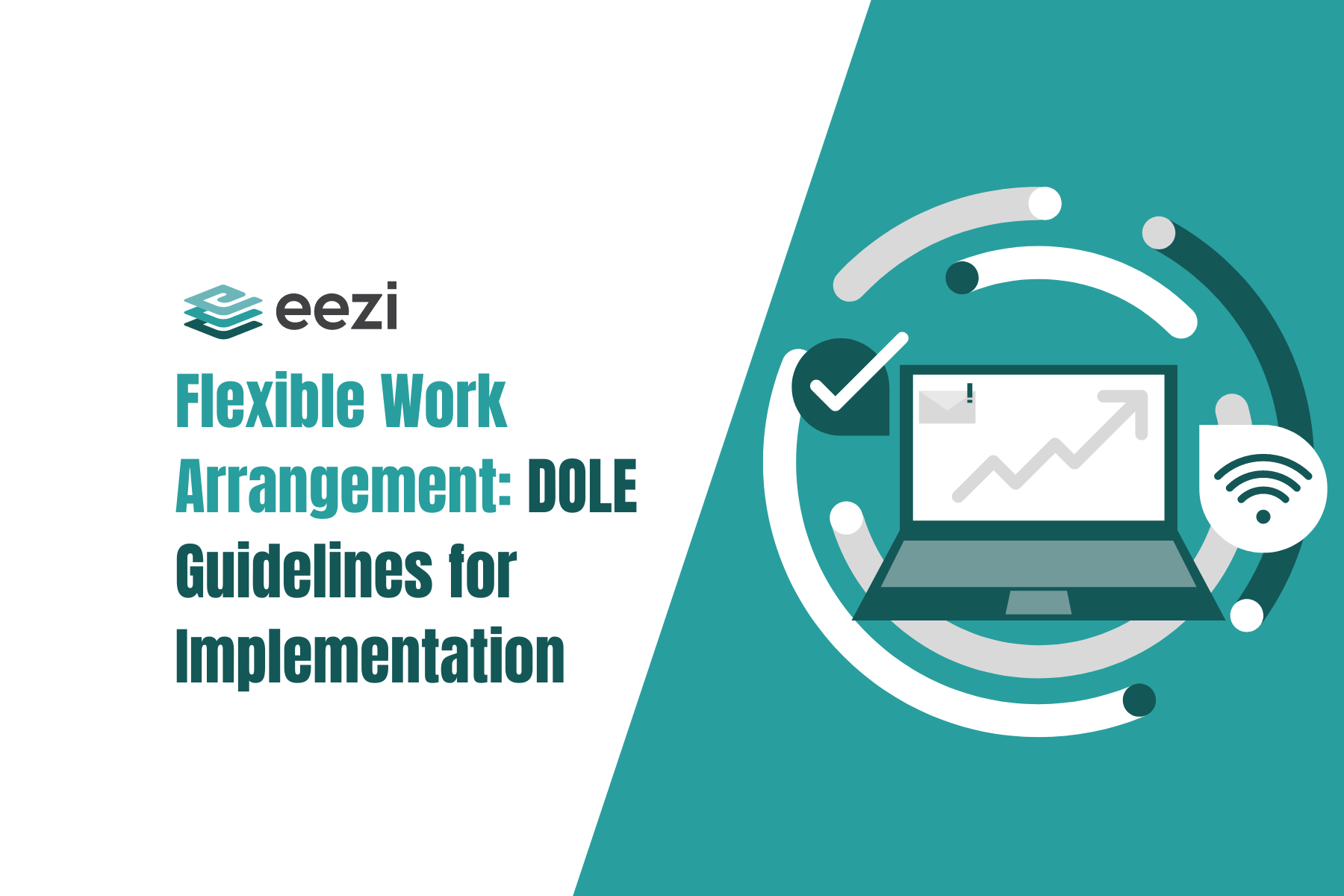Here’s what you need to know about the flexible work arrangement as implemented by DOLE.
What is a flexible work arrangement?

A flexible work arrangement, as the name suggests, is a work schedule arrangement that is not bound by the constraints of traditional work schedules.
In recent years, flexible work arrangements have become one solution to major changes in business situations. This results from economic difficulties due to the pandemic. However, other emergencies like national, military, or natural disaster crises can also call for a more flexible work setup or a compressed work schedule.
So why do businesses adopt flexible working arrangements or compressed work schedules? In most cases, hybrid work is a much better alternative to closing the business or firing employees.
Additionally, hybrid work is a good move to increase the company’s competitiveness and the employee’s productivity. Often, providing a compressed work schedule also leads to better job satisfaction.
DOLE guidelines on implementation

The Department of Labor and Employment (DOLE) released several guidelines for employers and employees. This is in line with adopting flexible work arrangements or compressed work schedules, namely the DOLE Labor Advisory (LA) No. 09-20 and Department Advisory (DA) No. 04-10. Let us go through them.
DOLE labor advisory on flexible work
Labor Advisory No. 09-20 was released in 2020 to strengthen and improve the provisions existing in DA No. 04-10. The provisions of LA No. 09-20 were released as remedial measures due to the coronavirus (COVID-19) pandemic.
The guidelines require employers to notify the DOLE if they ever wish to implement flexible working arrangements or compressed work schedules. Furthermore, the provisions ensure that the adoption of flexible work arrangements must not reduce existing employee benefits.
eezi HR Guide
Learn the efficient ways to set up your HR department.
What are the types of flexible work arrangements?
There are several types of flexible work arrangements, but the most common ones are compressed work week, job sharing, and telecommuting, to name a few. Moreover, DOLE has released several guidelines on the adoption and implementation of flexible work arrangements.
Here are the alternative employees’ work schedules to know:
Compressed work week
Employees who work compressed work weeks could be more productive in the hours outside of the regular workday when fewer coworkers are around.
The compressed schedule is a work arrangement where an employee’s workweek is compressed to less than six (6) days a week. However, this does not mean fewer hours, as the total working hours shall remain at 48 hours. This means that full time position employees will have to work longer hours when they do report.
In other words, a compressed workweek means each workday exceeds the regular eight (8) hours. However, it shall not exceed 12 hours per day. Moreover, the excess of work hours over the regular eight (8) standard business hours does not merit overtime pay.
You can apply the compressed workweek option for non-exempt (bi-weekly paid) employees with established maximum work hours. In addition, this is also an alternative for monthly paid employees who might work more than 40 hours per work week.
Non-exempt employees who consent to a compressed workweek must be compensated for overtime hours worked beyond 40.
Rotation of workers
Another type of flexible work arrangement is the rotation of workers. A group of workers is rotated such that they are alternatively provided work per week.
To illustrate, let’s say that in Group A, we have ten workers, called employees E1 to E10. Each day of the week can only accommodate four workers.
On Monday, employees E1 to E4 have work; on Tuesday, employees E5 to E8 are on duty; on Wednesday, employees E9, E10, E1, and E2 have work. On Thursday, employees E3 to E6 will be working, while employees E7 to E10 will work on Friday.
With this, all employees are given equal days of work duty, which is two days per week.
Reduction of workdays
This type of flexible work arrangement reduces the number of delegated work days per week of an employee.
If a full-time employee previously worked five days a week, from Monday to Friday, in this arrangement, he/she might only get a four-day workweek. However, the reduction in working hours is temporary in nature. It must only be effective for not more than six (6) months.
Broken-time schedule
The broken-time schedule is another example of a compressed work schedule where employees perform noncontinuous work hours. This means allowing employees to finish their daily or weekly work hours over the course of the whole day or week in a staggered manner.
Flexi-holidays schedule
Flexi-holidays schedule is a type of flexible work arrangement where the workers agree to take their holiday leaves on a different date, provided that there will be no diminution on their benefits due to the arrangement.
Forced leave
Forced leave refers to an arrangement where employees are forced to take leave for several days or weeks. In this process, they may use their leave credits if they have any.
Telecommuting
Another type of flexible work arrangements is telecommuting. Telecommuting is a work set-up where employees are allowed to work at home (or at work locations other than the office) as long as they are connected to the internet.
Flexitime schedule
Last on this list of work arrangements is the flexitime schedule. It is a working arrangement where an employee comes in for work and leaves at their desired time, but the necessary work time must be completed within the office. Flexible arrangements is also referred to as “gliding.”
Flexitime provides a chance for employees to better manage their personal time as they strive for a better work-life balance. It is most effective when work is mostly done by one employee or when asynchronous collaboration is possible.
Employees regularly rank work environment flexibility higher on their priority list than pay and career advancement. Since offering flex time is less expensive and quicker to execute than giving employees raises and promotions, employers are frequently eager to reward employees with it.

Pros and cons of flexible work arrangements
It is inevitable that every phenomenon, idea, and thing has a positive and negative side. The same concept applies to flexible work arrangements.
Let’s take a closer look at the advantages and disadvantages of flexible schedules.
Pros
Employees:
- Reduced or no work commute or fuel expenses
- Increased productivity
- Empowered employees
- More personal time or control over one’s own schedule
- Lowered childcare expenses
- Better accommodation of family needs
- Ability to choose to work when most productive
- Better work-life balance
Employers:
- Reduced compensation cost
- Boosted operational efficiency
- Reduced operational cost
- Reduced employee absenteeism and tardiness
- Lowered turnover rate
- Boosted employee morale
- Industry Competitiveness
- Better employee commitment
- Smooth operations
Cons
- Lower salaries
- Boundary lines between work and home fades
- False sense of availability for family and friends
- Possible distractions in a home setting
- Possibility of missing important announcements due to unstable connections
- Transition from an office setting to working from home may take some getting used to
- Feelings of isolation from the team
Employers:
- Employee procrastination
- Employees’ feelings of unfairness due to possible unequal distribution of work
- Increased stress from the adoption of compressed schedules
- Supervisors and managers may have a hard time communicating, supervising, and managing the employees under them
- Compressed work weeks may jeopardize possible client relations
Addressing challenges in implementing flexible work arrangements
To manage flexible work arrangements, employers or businesses should:
- Set clear expectations and goals for remote workers
- Establish regular check-ins and use performance metrics to maintain productivity
- Use various communication tools to ensure effective communication
- Foster collaboration through virtual team-building activities and collaborative platforms
- Support employee well-being by promoting a healthy work-life balance and providing mental health resources
By proactively addressing these challenges, businesses can successfully implement and manage flexible work arrangements while maintaining productivity and effective communication.
Manage employees better no matter the work arrangement
Manage your employees in any working arrangement with eezi. Do more with our highly configurable payroll for flexible work arrangements.



